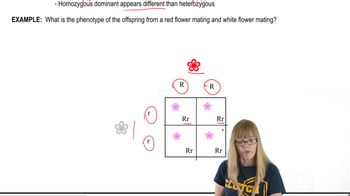Table of contents
- 1. Introduction to Genetics51m
- 2. Mendel's Laws of Inheritance3h 37m
- 3. Extensions to Mendelian Inheritance2h 41m
- 4. Genetic Mapping and Linkage2h 28m
- 5. Genetics of Bacteria and Viruses1h 21m
- 6. Chromosomal Variation1h 48m
- 7. DNA and Chromosome Structure56m
- 8. DNA Replication1h 10m
- 9. Mitosis and Meiosis1h 34m
- 10. Transcription1h 0m
- 11. Translation58m
- 12. Gene Regulation in Prokaryotes1h 19m
- 13. Gene Regulation in Eukaryotes44m
- 14. Genetic Control of Development44m
- 15. Genomes and Genomics1h 50m
- 16. Transposable Elements47m
- 17. Mutation, Repair, and Recombination1h 6m
- 18. Molecular Genetic Tools19m
- 19. Cancer Genetics29m
- 20. Quantitative Genetics1h 26m
- 21. Population Genetics50m
- 22. Evolutionary Genetics29m
17. Mutation, Repair, and Recombination
Types of Mutations
Problem 21
Textbook Question
The two DNA and polypeptide sequences shown are for alleles at a hypothetical locus that produce different polypeptides, both five amino acids long. In each case, the lower DNA strand is the template strand: allele A₁ 5′. . . ATGCATGTAAGTGCATGA. . . 3′ 3′. . . TACGTACATTCACGTACT. . . 5′ A₁ polypeptide N–Met–His–Val–Ser–Ala–C allele A₂ 5′. . . ATGCAAGTAAGTGCATGA . . . 3′ 3′. . . TACGTTCATTCACGTACT . . . 5′ A₂ polypeptide. N–Met–Gln–Val–Ser–Ala–C Based on DNA and polypeptide sequences alone, is there any way to determine which allele is dominant and which is recessive? Why or why not?
 Verified step by step guidance
Verified step by step guidance1
Step 1: Understand the concept of dominance and recessiveness in alleles. Dominance refers to an allele that expresses its phenotype even in the presence of a different allele, while recessiveness refers to an allele whose phenotype is masked by a dominant allele.
Step 2: Analyze the DNA sequences provided for both alleles A₁ and A₂. Note that the sequences differ at a specific point, which leads to a change in the amino acid sequence of the polypeptides they encode.
Step 3: Compare the polypeptide sequences resulting from each allele. Allele A₁ produces a polypeptide with the sequence Met–His–Val–Ser–Ala, while allele A₂ produces Met–Gln–Val–Ser–Ala. The difference is in the second amino acid: His in A₁ and Gln in A₂.
Step 4: Consider the information provided. The problem does not give any phenotypic information or context about the functional consequences of these polypeptides, which is crucial for determining dominance.
Step 5: Conclude that without additional phenotypic data or functional analysis, it is not possible to determine which allele is dominant or recessive based solely on the DNA and polypeptide sequences. Dominance is a phenotypic concept, not a genotypic one.
Recommended similar problem, with video answer:
 Verified Solution
Verified SolutionThis video solution was recommended by our tutors as helpful for the problem above
Video duration:
1mPlay a video:
Was this helpful?
Key Concepts
Here are the essential concepts you must grasp in order to answer the question correctly.
Alleles and Dominance
Alleles are different versions of a gene that arise by mutation and are found at the same place on a chromosome. Dominance refers to the relationship between alleles, where one allele can mask the expression of another. In genetics, a dominant allele will express its trait even in the presence of a recessive allele, while a recessive allele only expresses its trait when paired with another recessive allele.
Recommended video:
Guided course

Variations on Dominance
Transcription and Translation
Transcription is the process by which the DNA sequence of a gene is copied into messenger RNA (mRNA), which then undergoes translation to synthesize polypeptides (proteins). The sequence of nucleotides in DNA determines the sequence of amino acids in a polypeptide, which ultimately influences the protein's function. Understanding these processes is crucial for analyzing how genetic information is expressed.
Recommended video:
Guided course

Translation initiation
Phenotypic Expression
Phenotypic expression refers to the observable traits or characteristics of an organism, which result from the interaction of its genotype (the genetic makeup) with the environment. In the context of alleles, the phenotype can be influenced by whether an allele is dominant or recessive. However, without additional information about the functional effects of the polypeptides produced by the alleles, it is not possible to determine dominance solely from the sequences provided.
Recommended video:
Guided course

Penetrance and Expressivity

 9:49m
9:49mWatch next
Master Point Mutations with a bite sized video explanation from Kylia Goodner
Start learning



